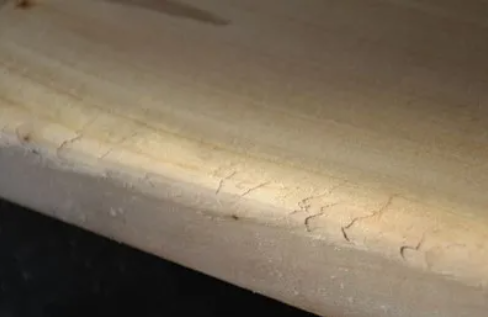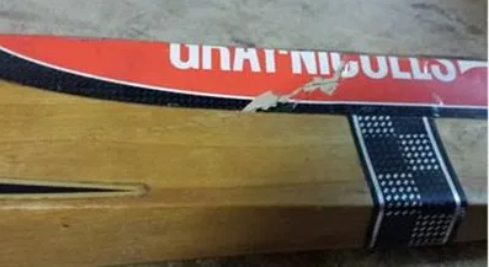CRICKET BAT WEAR AND TEAR
Like a pair of running trainers or tyres on a car, eventually, they wear out. The 'mileage' of a cricket bat depends on how many balls you hit and how hard you hit them.
It is normal for a bat to gain marks and surface cracking as it ages and is used more. This is regarded as normal wear and tear and does not detract from the bat's performance but may need some attention. Many players will treat these marks and cracks accordingly with fiberglass tape or PVA glue. If the bat is used heavily, then it might benefit from a full B3 refurbishment which will provide a full MOT and prolong the bats life.
We base our wear and tear policy on an average club player who may net once a week and bat in a match once a week during the season.
There are many B3 customers who play and train more regularly than the average club player. These include elite level players including professionals, county age group/ academy players and top-grade club players. These players tend to hit the ball harder, face faster bowlers, and engage in more intense, regular ball hitting. Another factor which reduces the lifespan of a cricket bat is shorter format cricket where players swing harder than ever at brand new white balls. These players will also practice ‘power hitting’ in training often with heavy balls which will damage or break a bat. This should be avoided, and we recommend these players have at least two bats and keep their best for matches to prolong its lifespan.
Bowling machines also increase the wear and tear on a cricket bat. We recommend that you don’t use your best match bat on bowling machines on a regular basis.
Our experts will base fair wear and tear on average club players and therefore elite level players may not be able to claim on the warranty if the bat in question exceeds these conditions.
As well as the wear and tear on the bat, we will also assess the bat has been prepared and cared for properly because these factors all make a difference to the performance and longevity of the bat.
TYPICAL BAT ISSUES
It is normal for a bat to gain marks and slight surface cracking as it ages and is used more. This is regarded as normal “wear and tear" and does not detract from the bat's performance. Many players will treat these marks and cracks accordingly with fiberglass tape or PVA glue. If the bat is used heavily, then it might benefit from a full B3 Refurb. B3 Cricket provides a full refurb service, for more information, please contact us via our contact form.
If you spot any of the danger signs detailed below or are in any doubt, then you should stop using the bat immediately and log the issue via our online form, Click Here.
We will access the damage from the images and information that you provide and advise you on the best course of action to avoid more severe damage to your bat.
Here are some of the warranty and repair issues we commonly see:
Edge Damage
The edges are more sensitive to impact damage than the face of the bat. Edge cracks are caused by the player mis-hitting or mistiming the ball. Lack of knocking-in and overly hard, cheap balls can also cause edge cracks.
Look out for cracks that run through the bat to the back of the bat. Cracks that run from the edge of the bat to the toe are also a more serious problem. Balls that accidentally strike the bat's leading edge due to mistiming can also cause significant damage or bruising.
Prevention
The best way to avoid edge cracks is to middle the ball like the top professionals! However, for mere mortals, you can expect to get marks, dents, abrasions, and cracks. This is normal wear and tear and will not affect the overall performance of your bat.
A good way to minimise edge damage is to have an anti-scuff sheet and/or fibreglass edge tape fitted to the bat before you use it. This will protect and strengthen the edges.
Repair Work
Minor cracks and abrasions (under an anti-scuff or edge tape) can be dealt with at the end of the season. In some cases, you may need to apply additional fibreglass tape to cover the crack.
If you aren’t sure or have a major crack, you should stop using the bat and seek advice from B3. Use our Issue Logging Form to send us details and photographs of the issue and we will advise accordingly.
HANDLE AND SPLICE
A lot of stress and torque goes through the handle and splice area of a cricket bat. Over time the splice (the 'V' where the handle meets the blade) may loosen or even crack. In rare cases, handles can break.
Prevention
Look out for a handle that starts to feel more flexible or bendy, starts to make a creaking sound or you notice a loss of hitting power. Please avoid power hitting practice with your best match bats and do not use heavy weighted balls.
Repair Work
If you notice a potential issue as described above, you should stop using the bat and seek advice from B3. Use our Issue Logging Form to send us details and photographs of the issue and we will advise accordingly.
THE FACE
Marks and surface cracks will develop as you use the bat more and you can expect to get marks, dents, abrasions, and cracks. This is normal wear and tear and will not affect the overall performance of your bat. These can be attended to at the end of the season or when you have your bat refurbished.
Prevention
Make sure you knock-in your bat in accordance with our guidelines and avoid overly hard cheap cricket balls. Having an anti-scuff sheet and/or fibreglass edge tape fitted to the bat before you use it, will protect and strengthen the bat face.
Repair Work
Minor cracks and abrasions (under an anti-scuff or edge tape) can be dealt with at the end of the season. In some cases, you may need to apply additional fibreglass tape to cover the crack. Look out for cracks that run through the bat to the back of the bat. Cracks that run from the edge of the bat to the toe are also a more serious problem.
If you aren’t sure or have a major crack, you should stop using the bat and seek advice from B3. Use our Issue Logging Form to send us details and photographs of the issue and we will advise accordingly.
Toe
The bat toe area is the most vulnerable area of your bat because it is thinner and not intended to strike the ball. However, if the ball does strike the toe area it can cause marks, dents, abrasions, and cracks. Yorkers are a bat's biggest enemy, and sometimes these can cause more severe damage. Other major issues for the toe of a cricket bat are damp and overzealous bat tapping.
Prevention
Make sure you knock-in your bat in accordance with our guidelines and avoid overly hard cheap cricket balls. Do not tap your bat on damp surfaces and do don’t tap too hard. If you do tap your bat as part of your pre-delivery routine, do it gently and evenly across the whole of the toe as opposed to the inside edge of the toe.
Finally, if you do get a yorker, try and just let the ball hit the bat as opposed to swinging hard at the ball. It is the swing speed at impact which traps the ball between the bat and the ground that causes the most damage.
Repair Work
Minor cracks and abrasions (under an anti-scuff or edge tape) can be dealt with at the end of the season. In some cases, you may need to apply additional fibreglass tape to cover the crack. Look out for cracks that run through the bat to the back of the bat. Cracks that run from the front to the back of the bat in the toe area are a more serious problem.
If you aren’t sure or have a major crack, you should stop using the bat and seek advice from B3. Use our Issue Logging Form to send us details and photographs of the issue and we will advise accordingly.




